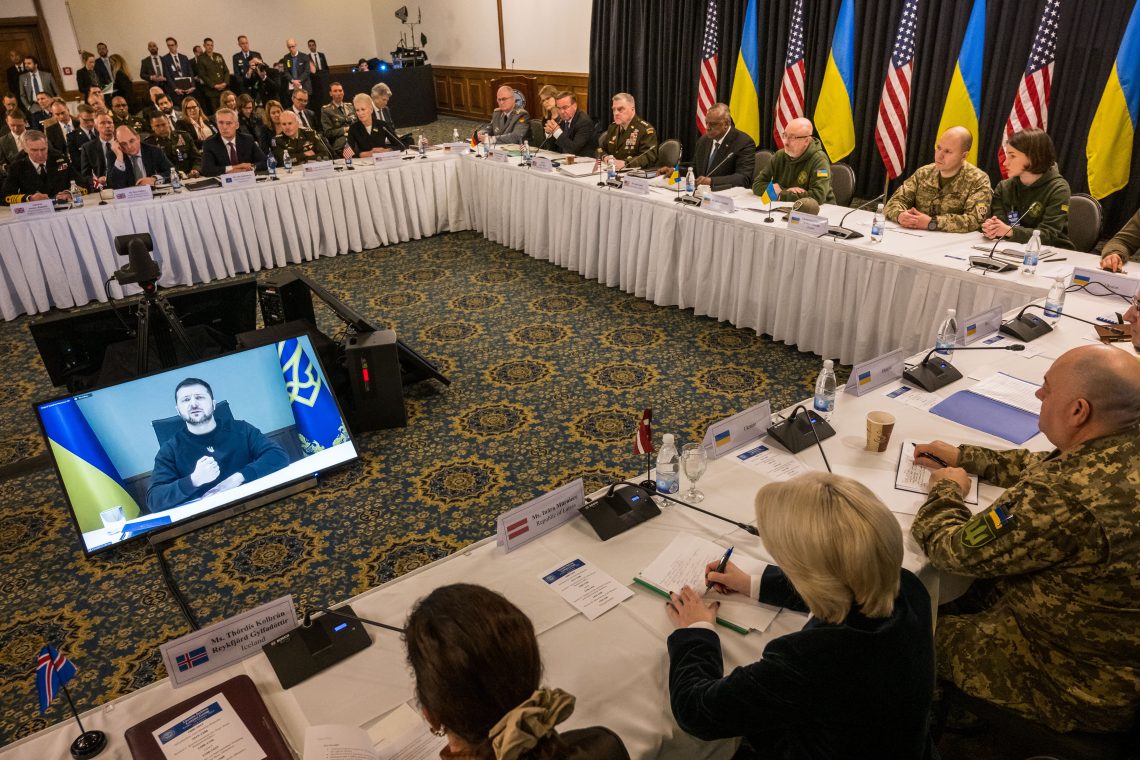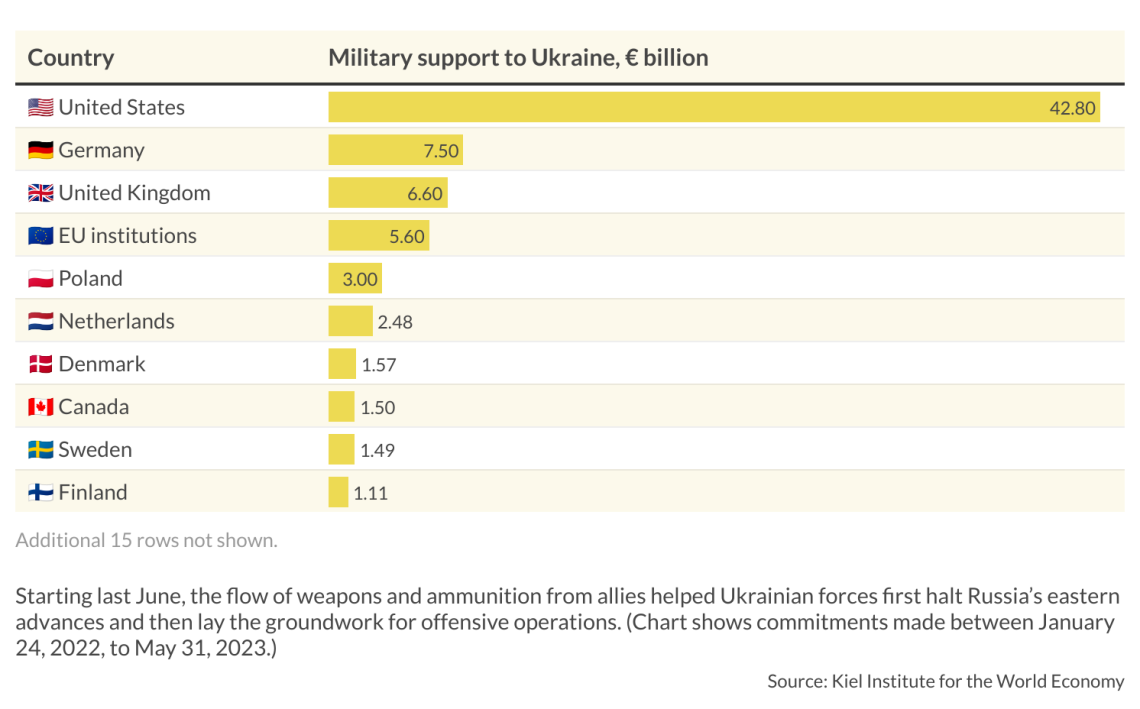Why Ukraine needs weapons right now
Sending weaponry to Kyiv fulfills several objectives for the West: defending international norms and rules of the civilized world, degrading Russia’s military, and bolstering Ukrainian security in the absence of NATO membership.

In a nutshell
- Military aid has fueled Ukraine’s success against Russia
- Kyiv now needs projectiles, aircraft, demining equipment and more
- Western weaponry can blunt the future spread of Russian aggression
This is a special opinion report authored by Oleksiy Danilov, Secretary of the National Security and Defense Council of Ukraine.
For nearly a year and a half, Ukrainians have been those bleeding Russia dry and destroying its military potential. Not a single NATO soldier is fighting in the war. Ukraine’s most important resource is human, but Russia still has the advantage in terms of numbers.
Western weapons in sufficient quantities, at the right time and of the right type, will protect the lives of Ukrainian soldiers and civilians. It is Ukrainians who will solve the urgent problems of its present counteroffensive, liberate the territories seized by Russia, and prevent the spread of Russian aggression to other European countries.
Mutual interest
When, on February 24, 2022, Russia decided to broaden its aggression against Ukraine with an all-out invasion, the foreign supply of weaponry and ammunition to Ukraine assumed paramount importance. Foreign military supplies are necessary for Ukraine to exercise its self-defense, as provided by Article 51 of the United Nations Charter. If Ukraine is not successful in the conflict with Russia, the most fundamental norms enshrined in the UN charter would be called into question – with all manner of negative repercussions for both European and global security.
It is squarely in the self-interest of UN members to aid Ukraine in its own defense. Moreover, sustaining Ukraine’s capacity to fight is an opportunity for NATO and Western-leaning countries to see Russian forces degraded, helping limit the threat posed by Moscow of high-intensity, conventional war in the next seven to 10 years.
Initial defense
During the first month of the war, Ukraine managed to foil Russia’s original military plans with a combination of Soviet-era heavy weaponry – main battle tanks (MBTs), tube and rocket artillery, surface-to-surface missiles, mid-range surface-to-air missile (SAMs) and combat planes – as well as limited light Western-supplied weaponry like anti-tank guided missiles and man-portable air defense systems (like Javelin, NLAW and Stinger systems).
However, the stock of munitions for Soviet weaponry dwindled, and from mid-April 2022, the countries organized as the Ukraine Defense Contact Group (the “Ramstein group”) began supplying Kyiv with heavy weaponry and ammunition. This has included 155mm and 105mm howitzers, antiship missiles, multiple launch rocket systems (the M142 HIMARS and M270 MARS), SAMs (the NASAMS, IRIS-T, and Patriot), MBTs, infantry fighting vehicles, armored personnel carriers and air-to-surface cruise missiles. The rationale was simple: no European country would have been able, on its own, to sustain the level and intensity of fighting Ukraine has endured.

If Ukraine can attain the goals of its current offensive operation, it will be able to maintain long-term attention and aid from Western countries.
Tube and rocket artillery, along with its ammunition, was the top priority for Ukraine, as the war with Russia turned into a battle of artillery in which neither side could secure air superiority. To some extent, Western howitzers were supplied to sustain a minimal level of fire support for maneuver formations.
But mostly, Russia’s advantage in tube and rocket artillery was dealt with asymmetrically by the United States and its allies: through the supply to Ukraine of M142/M270 systems and guided multiple launch rocket systems (GMLRS) ammunition. Using this combination, starting in late June 2022, Ukraine was able to first halt Russian artillery advances in the country’s east and then lay the conditions for offensive operations by targeting Russian rear warehouses, command and control nodes and logistics.
Offensive goals
Air defense systems became a major priority for Western assistance to Ukraine last October, as Moscow started to target its energy infrastructure with air-launched cruise missiles and Iranian-supplied, loitering kamikaze drones. At the same time, Ukraine’s stock of Soviet SAM missiles had decreased, posing Kyiv with a dilemma. It could choose to protect energy infrastructure, on which the normal functioning of the state depends; but that would risk depleting its interceptors’ stock, thereby opening the door for Russia to freely employ piloted aviation over the whole of Ukraine, with grave consequences.
Since January 2023, Ukraine has aimed to create a grouping of forces capable of liberating large swathes of territory in the southern mainland. To attain this goal, several mechanized and motorized brigades have been prepared, along with a supply of additional artillery and ammunition. If Ukraine can attain the goals of its current offensive operation, it will be able to maintain long-term attention and aid from Western countries.
Read more on the war in Ukraine
A determined West can prevent Russia from using nuclear weapons
Projectile demand
The main objective in modern warfare is taking and maintaining control of the situation: taking the initiative, securing advantages in efficiency and mobility, and being able to deliver precision strikes over long distances. Hence, Ukraine needs timely deliveries of specific weapons and military equipment, in sufficient quantities and without unnecessary restrictions on their use.
As of July 2023, the main challenge that Ukraine may face during its offensive operation is the shortage of 122mm, 152mm and 155mm high-explosive projectiles. The Biden administration has recently decided to provide Ukraine with M864 cluster munitions, both to support the Ukrainian offensive and to buy time to increase the production of these high-explosive projectiles.
In addition, Ukraine still needs more short-range cruise and ballistic missiles to target Russian headquarters, depots and key logistics routes in the deep rear. The decision by the British and French governments to supply air-launched cruise missiles (such as the Storm Shadow/SCALP) is a welcome step, as it may finally push Washington to give a green light to supply Ukraine with short-range ballistic missiles, such as Army Tactical Missile Systems (ATACMS).
Aircraft
Yet the major element that would not only close the skies over Ukraine but also help in effective counteroffensives is the supply of modern, multifunctional aircraft. Kyiv is aware of the complex and relatively lengthy preparations that the combat use of Western aircraft would require, including the development of relevant infrastructure and maintenance systems and the training of pilots and technicians.
Nevertheless, aircraft and helicopters are needed now. Large-scale military operations are impossible without air superiority. An interim temporary solution is to further provide Ukraine with Soviet-era aircraft that remain in service and storage in some post-socialist countries.
The war in Ukraine is gradually turning into a drone conflict. Bayraktar-class unmanned aerial vehicles proved highly effective in the first stage of the conflict, while tactical drones have been invaluable on the front lines. Ukraine’s need for them remains high, as Russia has a five-to-one numerical advantage in drones of various types.
Mines, repairs, training and the cyber domain
Another of Ukraine’s needs is modern robotic equipment, platforms and vehicles for mechanized demining. Russia has recently begun to destroy Ukrainian forces’ engineering equipment with missiles and drones. It will be vital for Kyiv to equip its units with the latest and most reliable demining and engineering equipment.
Maintenance and repair facilities for Western weapons are mostly located outside Ukraine. For example, the German manufacturer Rheinmetall plans to open a repair and logistics hub in Romania, near the Ukrainian border, where self-propelled howitzers, German Leopard 2 tanks and British Challenger tanks will be repaired, as well as Marder infantry combat vehicles, army trucks and Fuchs armored personnel carriers. In addition, Leopard 2 tanks (of the A5 and A6 versions) will be repaired in Germany and possibly also in Lithuania, and the A4 model in Poland.
All this leads to complicating logistics chains – and, most importantly, slows down the process of replenishing reserves and returning damaged equipment to the battlefield. Ukraine urgently needs to develop its own network of service centers and accelerate the training of technical personnel with the help of partners.
Facts & figures
A separate issue is the training of Ukrainian military personnel up to NATO standards. Currently, basic training is conducted abroad for five weeks. Ukraine needs to move toward the comprehensive training of personnel and the formation of combat-ready units, to at least battalion level, on a turnkey basis. This should include basic tactical training, a mastery of Western weapons and the combat coordination of units, providing them with gear and military equipment.
Ukrainians are fast learners. American, British and Western European instructors have been impressed by how well their soldiers have mastered the combined use of various weapons systems, partly thanks to combat experience rarely available to their NATO counterparts.
Cyberspace is another battlefield to keep in mind. Throughout the war, Ukraine and its military, civilian and energy infrastructure have been subjected not only to massive missile strikes but also cyberattacks from Russia. Without further delay, Ukraine must move to an active cyber defense, employing not only electronic warfare but also cyber weapons.
Western concerns
Two major issues have so far affected Western ability and willingness to provide Ukraine with the necessary amount of military resources. For the Biden administration, the first concern was managing the risk of escalation: how to simultaneously aid Ukraine in its self-defense while minimizing the possibility of unconventional Russian escalation (about which the Kremlin has actively dropped hints since February 2022). In a number of cases, these escalation considerations delayed or decreased the shipment of weaponry to Ukraine, as the White House sought a balance. Nevertheless, Moscow’s expectations that its threats to escalate would prevent Western military aid to Ukraine have generally proven wrong.
The second issue is the challenges facing the Western military-industrial complex to sustain a sufficient ammunition supply, given the post-Cold War disinvestment in the area. A good example is the 155mm high-explosive projectile; while Ukraine consumes a minimum of 90,000 shells monthly, the U.S. produces only 24,000 a month. This dynamic is becoming increasingly salient, with enduring negative consequences for Ukraine, as the Biden administration agrees to greenlight weapons shipments that were previously considered off the table.

Long-term benefits
It is not only Ukraine that will benefit from the continued supply of weapons. Its Western partners are also gaining unique experience.
Before the war, Western defense companies were stagnating; today their stocks are soaring. Shares in Lockheed Martin, the world’s leading arms seller, grew by almost 40 percent in 2022, while those of German Rheinmetall almost tripled. The Western defense industry has also realized a prime opportunity to test its latest developments in a modern high-intensity war, which has not been seen since World War II.
The war in Ukraine has become a kind of testing ground in many areas, including scientific and technical intelligence. Western arms manufacturers have gained access to Russian military developments, as well as some Iranian weapons.
Beyond the present conflict, Western military aid is also aimed at rebuilding a Ukrainian military capable of establishing deterrence by denial – a strategy of deterring conflict by making it infeasible. Such an approach requires the ability to inflict major damage to Russian forces, if needed, thereby breaking the cycle of Russian aggression. The long-term Western delivery of weaponry and ammunition is a way for NATO countries to bolster Ukraine’s security into the future, despite the lack of readiness to admit Ukraine into NATO in the near term, and to distribute more evenly the risks and costs of combating Russian revanchism.
These reflections do not cover the Chinese factor in the Russian-Ukrainian war. However, this is a separate topic for consideration.











